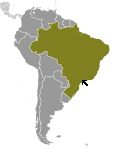World Atlas: Brazil. On this page you can see the map, country flag and many detailed information about the people, history and economy of Brazil.

Here you can find online selected information about the geography, inhabitants, government, economy and history of Brazil. Included are selected statistics, an overview map and the detailed map of Brazil. But let's start with the flag of Brazil here:
Brazil - Overview:
What you should know about Brazil? Let's start with this: Following more than three centuries under Portuguese rule, Brazil gained its independence in 1822, maintaining a monarchical system of government until the abolition of slavery in 1888 and the subsequent proclamation of a republic by the military in 1889. Brazilian coffee exporters politically dominated the country until populist leader Getulio Vargas rose to power in 1930. By far the largest and most populous country in South America, Brazil underwent more than a half century of populist and military government until 1985, when the military regime peacefully ceded power to civilian rulers. Brazil continues to pursue industrial and agricultural growth and development of its interior. Having successfully weathered a period of global financial difficulty in the late 20th century, Brazil was seen as one of the world’s strongest emerging markets and a contributor to global growth. The awarding of the 2014 FIFA World Cup and 2016 Summer Olympic Games, the first ever to be held in South America, was seen as symbolic of the country’s rise. However, since about 2013, Brazil has been plagued by a shrinking economy, growing unemployment, and rising inflation. Political scandal resulted in the impeachment of President Dilma Rousseff in May 2016, a conviction that was upheld by the Senate in August 2016; her vice president, Michel Temer, will serve as president through 2018, completing her second term.
Geography of Brazil
 Where on the globe is Brazil? The location of this country is Eastern South America, bordering the Atlantic Ocean. Total area of Brazil is 8,515,770 sq km, of which 8,358,140 sq km is land. This is one of the largest countries in the World. How could we describe the terrain of the country? This way: mostly flat to rolling lowlands in north; some plains, hills, mountains, and narrow coastal belt. The lowest point of Brazil is Atlantic Ocean 0 m, the highest point Pico da Neblina 2,994 m. And the climate is mostly tropical, but temperate in south.
Where on the globe is Brazil? The location of this country is Eastern South America, bordering the Atlantic Ocean. Total area of Brazil is 8,515,770 sq km, of which 8,358,140 sq km is land. This is one of the largest countries in the World. How could we describe the terrain of the country? This way: mostly flat to rolling lowlands in north; some plains, hills, mountains, and narrow coastal belt. The lowest point of Brazil is Atlantic Ocean 0 m, the highest point Pico da Neblina 2,994 m. And the climate is mostly tropical, but temperate in south.
Inhabitants of Brazil
Let's take a look how many people live in Brazil. The number is: 207,353,391 (July 2017 est.). So this country is among the most populous in the World. Who lives here? white 47.7%, mulatto (mixed white and black) 43.1%, black 7.6%, Asian 1.1%, indigenous 0.4% (2010 est.). What are the languages in Brazil? Portuguese (official and most widely spoken language). And the religions: Roman Catholic 64.6%, other Catholic 0.4%, Protestant 22.2% (includes Adventist 6.5%, Assembly of God 2.0%, Christian Congregation of Brazil 1.2%, Universal Kingdom of God 1.0%, other Protestant 11.5%), other Christian 0.7%, Spiritist 2.2%, other 1.4%, none 8%, unspecified 0.4% (2010 est.). How old are the people in average? 32 years. We have to add that this number is the median - so one half of the people is older than this, one half is younger. And what is their life expectancy (at birth)? This: 74 years. Where the people live in Brazil? Here: the vast majority of people live along, or relatively near, the Atlantic coast in the east; the population core is in the southeast, anchored by the cities of Sao Paolo, Brasilia, and Rio de Janeiro. The major urban areas of Brazil are: Sao Paulo 21.066 million; Rio de Janeiro 12.902 million; Belo Horizonte 5.716 million; Brasilia (capital) 4.155 million; Fortaleza 3.88 million; Recife 3.739 million (2015).
Government and Economy of Brazil
The capital of Brazil is Brasilia and the government type federal presidential republic. Let's take a look at the administrative divisions - 26 states (estados, singular - estado) and 1 federal district (distrito federal); Acre, Alagoas, Amapa, Amazonas, Bahia, Ceara, Distrito Federal, Espirito Santo, Goias, Maranhao, Mato Grosso, Mato Grosso do Sul, Minas Gerais, Para, Paraiba, Parana, Pernambuco, Piaui, Rio de Janeiro, Rio Grande do Norte, Rio Grande do Sul, Rondonia, Roraima, Santa Catarina, Sao Paulo, Sergipe, Tocantins. Regarding the economy of Brazil, important industrial products are textiles, shoes, chemicals, cement, lumber, iron ore, tin, steel, aircraft, motor vehicles and parts, other machinery and equipment. Important agricultural products are coffee, soybeans, wheat, rice, corn, sugarcane, cocoa, citrus; beef. The most important export commodities are transport equipment, iron ore, soybeans, footwear, coffee, automobiles and the most important export partners are China 19%, US 12.6%, Argentina 7.3%, Netherlands 5.6% (2016). The most important import commodities are machinery, electrical and transport equipment, chemical products, oil, automotive parts, electronics and the most important import partners are US 17.6%, China 16.9%, Argentina 6.7%, Germany 6.6%, South Korea 4.4% (2016). How rich is Brazil and how rich are people in this country? The most important number here is GDP per capita (PPP): $15,500 (2017 est.). This is quite good. Let's add that this means Gross Domestic Product per person, which is recalculated with respect to the relative cost of local goods and services. And one more important number - population below poverty line: 3.7%.